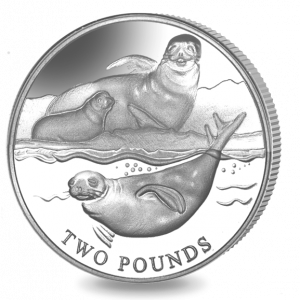Europe’s Pobjoy Mint recently announced the release of its latest blue titanium animal coin, this featuring a mother seal and her pup resting on pack ice while the father leaves to hunt.
Each £2 Blue Crabeater Seal coin—issued on behalf of the British Antarctic Territory—is technically unique and varies slightly in colour owing to the way titanium reacts to the coin-striking process. There’s also a “lined effect,” which is unique to this metal, on each coin.
The coin’s obverse features the Pobjoy-exclusive effigy of Queen Elizabeth II.
SPECIFICATIONS
| Composition |
.990 titanium |
Uncirculated cupro-nickel |
| Diameter |
36.10 mm |
38.60 mm |
| Weight |
10 grams |
28.28 grams |
| Mintage |
7,500 pieces |
10,000 pieces |

A cupro-nickel version (shown above) was also struck by the mint.
CRABEATER SEAL
The crabeater seal (Lobodon carcinophaga) is found in a circumpolar distribution around the coast of Antarctica. Despite its name, the mammal does not feed on crabs; its diet includes other crustaceans such as krill, which the seal—with their specially adapted sieve like teeth—are proficient at hunting. The crabeater seal is by far the world’s most abundant seal with more than seven million individuals worldwide.
Crabeaters move in a similar fashion to snakes and can reach speeds of 26 km/h on land over short distances. In the water, they can swim at speeds of up to 12 km/h and cover over 60 kilometres in one day. They congregate on the ice in groups of up to 1,000 individuals and can be found swimming in unison in groups of several hundred in the water.
The crabeater pups are big babies. At birth, they weigh between 20 kilograms and 30 kilograms and measure about 120 centimetres in length. During their nursing period, they grow at a fast rate of up to four kilograms a day. They can weigh more than 100 kilograms by the time they are only two weeks old.
The pups are also an important part of the diet of the leopard seal—80 per cent of all pups share this unfortunate fate.
Seals of all ages are also hunted by killer whales; this normally occurs in open water, but co-ordinated attacks—such as the use of waves to knock the seals from floating ice—have been documented.


